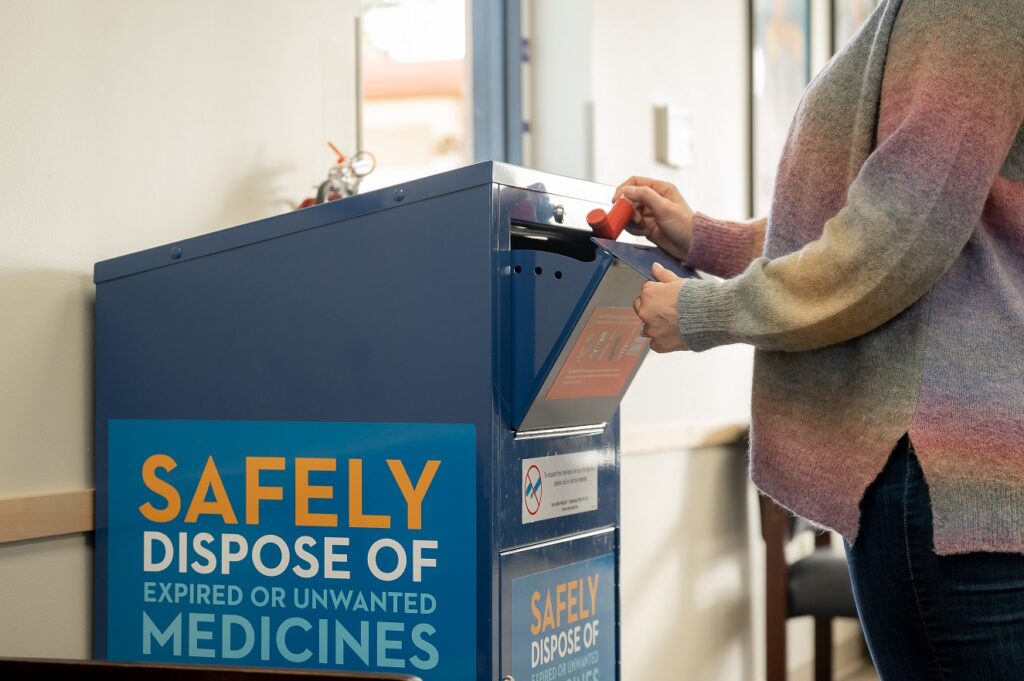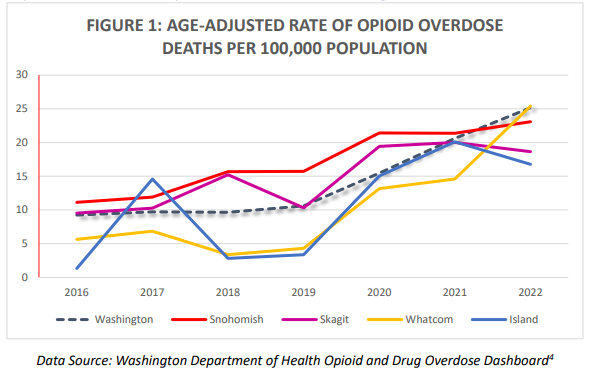Quickly jump to:
In our journey towards better health and well-being, managing chronic pain can often be a significant challenge. Whether it’s stemming from a medical condition, injury, or other factors, chronic pain can greatly impact our daily lives. At Unity Care NW, we understand the complexities of chronic pain management and the risks associated with opioid therapy. That’s why we’re committed to providing you with comprehensive support and information to empower you in your health journey.
Whatcom County Overdose facts
The opioid crisis has deeply impacted communities in Northwest Washington and across the United States. In 2022, Washington state experienced a significant increase in drug overdose deaths, with overdose deaths in Whatcom County surpassing the statewide average. The COVID-19 pandemic worsened the crisis by increasing factors like anxiety and social isolation, leading to more drug use and exacerbating the epidemic. Whatcom County Emergency Medical Services receives an average of 3 to 4 overdose calls per day.[1] It is crucial that the public be aware of what opioids are and how to prevent addiction and overdose in themselves and in their loved ones.
What is an Opioid?
Natural, synthetic, or semi-synthetic chemicals that interact with opioid receptors on nerve cells in the body and brain, and reduce the intensity of pain signals and feelings of pain. This class of drugs includes the illegal drug heroin, synthetic opioids such as fentanyl, and pain medications available legally by prescription, such as oxycodone, hydrocodone, codeine, morphine, and many others. Prescription opioids are generally safe when taken for a short time and as directed by a doctor, but because they produce euphoria in addition to pain relief, they can be misused and can lead to addiction.
Pain Management
Physical pain is a complex sensation that serves as a signal from the body to the brain, indicating injury or potential harm. It can manifest as aches, throbbing, sharp sensations, or discomfort in various parts of the body. While pain is a natural and often necessary response to protect ourselves from further injury, managing physical pain is an important part of promoting overall well-being and maintaining functional abilities. [3]
Pain management can be done in many ways that do not include opioids. Examples include:
- Physical therapy
- Exercise
- Nonopioid medications, such as acetaminophen or ibuprofen
- Cognitive behavioral therapy (CBT) including UCNW’s Wellness Skills Group for Chronic Pain
- Certain antidepressant and antiseizure medications
Chronic Pain
Chronic pain is pain lasting three months or more. It can be caused by a disease or condition, injury, medical treatment, inflammation, or even an unknown reason. There are many possible options to treat your chronic pain. You and your doctor should work together to establish treatment goals for pain and function in your daily life. Nonopioids treatments are recommended for first line treatment of most origins of chronic pain. Opioids should be used only when other options fail or conflict with other medical conditions or treatments.
If You Are Prescribed Opioids for Chronic Pain Management
- Follow up with your doctor within the first few days of starting your prescription to ensure opioids are helping. You should also discuss:
- What kind of pain relief and improvement you can expect overall. Opioids can reduce pain in the short-term but will not likely relieve all your pain.
- Any side-effects you are experiencing.
- Develop your personal pain management plan with your doctor which may include:
- Your personal treatment goals, which describe what you may achieve as you make progress.
- Information about treatment options.
- Referral to specialists as needed.
Side Effects of Opioid Therapy
Prescription opioids carry serious risks of addiction and overdose. Opioids can slow a person’s breathing, often a sign associated with someone experiencing an opioid overdose that can cause death. The use of prescription opioids can have several side effects as well, even when taken as directed, including:
- Tolerance — you might need to take more of a medication for the same pain relief
- Physical dependence — you have symptoms of withdrawal when a medication is stopped, or you take less
- Increased sensitivity to pain
- Nausea and vomiting
- Constipation
- Confusion
- Depression
- Sleepiness and dizziness
How to Spot an Opioid Overdose
Recognizing an opioid overdose can be difficult. If you aren’t sure, it is best to treat the situation like an overdose—you could save a life.
Signs of an overdose may include:
- Small, constricted “pinpoint pupils”
- Falling asleep or loss of consciousness
- Slow, shallow breathing
- Choking or gurgling sounds
- Limp body
- Pale, blue, or cold skin
Narcan/Naloxone
Carrying and knowing how to use Narcan (also known as Naloxone) can help you save someone from an opioid overdose. Narcan saves lives because it can quickly restore normal breathing to a person whose breathing has slowed or stopped as a result of overdosing on prescription opioid medications, heroin, or drugs that are adulterated and contaminated with an opioid like fentanyl (e.g., cocaine, methamphetamine).
To assist a person with an expected opioid overdose:
- Call 911.
- Give Narcan if possible.
- Try to keep the person awake and breathing.
- Lay the person on their side to prevent choking.
- Do not leave the person alone while waiting for help to arrive.
- Naloxone is a temporary treatment. More than one dose might be needed under some circumstances, especially if an overdose event involves illicitly manufactured fentanyl and fentanyl-related substances.[4]
Where to Get Narcan
A prescription is not needed to obtain Narcan. Narcan is covered by many insurances and is available at pharmacies, including Unity Care NW’s in-house pharmacies in Bellingham and Ferndale. Speak to your pharmacist to see if your insurance covers Narcan.
Whatcom County provides Narcan to At-Risk individuals or family members, or involved bystanders of opioid related overdose through the Narcan Leave Behind Program. Contact Steven Cohen, EMS Training Specialist, at 360-820-6157 or scohen@co.whatcom.wa.us for information on Narcan Kits and training.
You can also request free Narcan to be delivered to your home online through the Washington State Naloxone Mail Order program.
Safe Medication Return at UCNW
If you have unused or expired medications, including opioids, we offer a safe medication return program to ensure they are disposed of properly. Bring any medications you have to drop boxes at our pharmacies in either Bellingham or Ferndale to safely dispose of them. By participating in this program, you’re not only protecting your loved ones from potential harm but also contributing to environmentally responsible practices.
Sources
[1] https://www.whatcomcounty.us/4022/Narcan-Leave-Behind-Program
[2] The Opioid Crisis in Washington’s Second Congressional District and a Comprehensive Solution. January 2024. Rick Larsen. https://larsen.house.gov/uploadedfiles/rick_larsen_district_opioid_report_final.pdf
[3] https://www.cdc.gov/opioids/patients/therapy-expectations.html
[4]https://www.cdc.gov/opioids/naloxone/factsheets/pdf/Naloxone_FactSheet_Family_and_Caregivers_How_and_When_to_use_Naloxone.pdf
